Sarah Sundin's Blog, page 473
June 19, 2012
Today in World War II History
70 Years Ago—June 19, 1942: American Vice Adm. Robert Ghormley assumes command of South Pacific Area and South Pacific Force.
Published on June 19, 2012 03:00
June 18, 2012
Make It Do - Scrap Drives in World War II
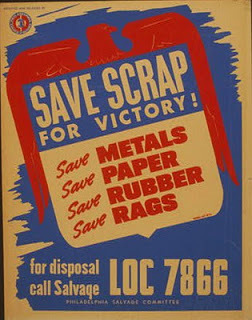 Perhaps nothing represents the community-minded patriotism of the US Home Front in World War II better than the scrap drive.
Perhaps nothing represents the community-minded patriotism of the US Home Front in World War II better than the scrap drive.Seventy years ago, the United States was in the middle of its first major national scrap drive - for rubber.
Enemy conquests cut off supplies of crucial raw materials such as tin and rubber, and the need for products made from these materials skyrocketed due to the war. Since useful materials often ended up in the trash can or languished unused in homes and on farms, the War Production Board encouraged scrap drives throughout the war.
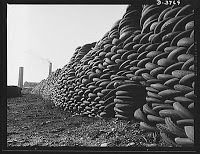 Rubber Drive
Rubber DriveFrom June 15-30, 1942, the United States held a nationwide rubber drive. People brought in old or excess tires, raincoats, hot water bottles, boots, and floor mats. In exchange they received a penny a pound. Although 450,000 tons of scrap rubber was collected, used rubber was found to be of poor quality.
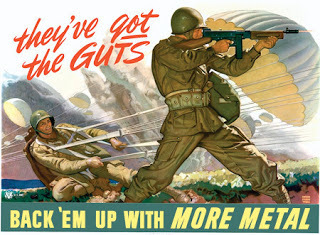 Scrap Metal Drives
Scrap Metal DrivesIn 1942 citizens scoured their homes, farms, and businesses for metal. Housewives donated pots and pans, farmers turned in farm equipment, and children even sacrificed their metal toys. Many people removed bumpers and fenders from their cars for the war effort. Communities melted down Civil War cannons and tore down wrought iron fences, sacrificing their history for their future.
These drives were often great community events, with performers, speeches, and opportunities to throw your scrap metal at a bust of Hitler. Competitions were held to see which town, county, and state produced the most scrap, and the winners boasted of their feats. These drives had mixed results. Used aluminum was found to be useless for aircraft, but used tin, steel, and copper were easily melted down and reused.
Tin Can Drives
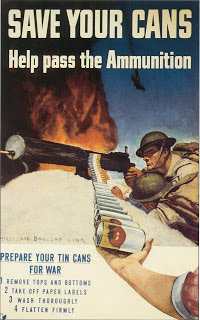 The use of tin packaging was greatly reduced during the war, due to the use of alternative packaging materials and to rationing of canned goods. However, consumer use of tin continued throughout the war, and this irreplaceable resource needed to be recovered.
The use of tin packaging was greatly reduced during the war, due to the use of alternative packaging materials and to rationing of canned goods. However, consumer use of tin continued throughout the war, and this irreplaceable resource needed to be recovered.Most communities collected tin cans once a month. In some towns, people places boxes of cleaned and crushed tin cans by the curb for collection, and other towns had central collection sites. Youth groups, especially the Boy Scouts, were highly involved in these drives.
Paper Drives
The need for paper increased during the war. The military’s love for paperwork could be blamed, but the military also used lots of paper packaging for supplies. On the civilian side, paper packaging had replaced tin for many products.
A paper drive in mid-1942 brought in so much paper that mills were inundated and actually called for a stop. However, by 1944 an acute paper shortage existed.
The lumber industry was hard-hit by the manpower shortage caused by the draft. Lumberjacks went on strike, demanding a higher meat ration, which they did not receive. Many of these men left for higher-paying jobs in the defense industry.
Publishers found their paper allotment cut by 15 percent. Newspapers, magazines, and books were printed on fewer pages with thinner paper and narrow margins. Paperback books had been introduced in 1939 and also allowed for less paper. However, more scrap paper was needed.
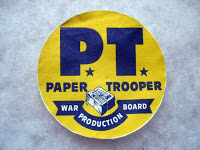 The children of America stepped up. The Boy Scouts and local schools organized regular paper drives, often coordinated with the tin can drives. The War Production Board started the Paper Troopers program, designed to sound like “paratroopers,” to involve schoolchildren in the effort. Participants received arm patches and certificates for collecting certain amounts. Results
The children of America stepped up. The Boy Scouts and local schools organized regular paper drives, often coordinated with the tin can drives. The War Production Board started the Paper Troopers program, designed to sound like “paratroopers,” to involve schoolchildren in the effort. Participants received arm patches and certificates for collecting certain amounts. ResultsScrap drives were a vital part of the American war effort. While not all scrap materials proved useful, many did and provided a small but significant source of material. Most importantly, these drives galvanized the Home Front and made each individual, even children, feel like a crucial part of the war effort.
Published on June 18, 2012 05:00
Today in World War II History
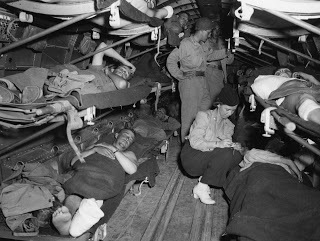 Medical Air Evacuation, Sicily, July 194370 Years Ago—June 18, 1942: Gen. Carl Spaatz officially takes command of US 8th Air Force, opens headquarters in Bushy Park in London suburbs. Germans kill Czech men who assassinated Gen. Heydrich in church in Prague. US Navy commissions first black officer, medical student Barnard Robinson. US Army Air Forces authorized to develop medical air evacuation system.
Medical Air Evacuation, Sicily, July 194370 Years Ago—June 18, 1942: Gen. Carl Spaatz officially takes command of US 8th Air Force, opens headquarters in Bushy Park in London suburbs. Germans kill Czech men who assassinated Gen. Heydrich in church in Prague. US Navy commissions first black officer, medical student Barnard Robinson. US Army Air Forces authorized to develop medical air evacuation system.
Published on June 18, 2012 03:00
June 17, 2012
Today in World War II History
 70 Years Ago—June 17, 1942: Germans take British fortress El Adem, last obstacle before Egyptian border. Four German saboteurs landed by U-202 at Ponte Vedra Beach near Jacksonville, Florida. Yank Magazine for servicemen first published.
70 Years Ago—June 17, 1942: Germans take British fortress El Adem, last obstacle before Egyptian border. Four German saboteurs landed by U-202 at Ponte Vedra Beach near Jacksonville, Florida. Yank Magazine for servicemen first published.
Published on June 17, 2012 03:00
June 16, 2012
Today in World War II History
70 Years Ago—June 16, 1942: Aleuts from St. Paul Island evacuated by US to Funter Bay, Alaska for internment.
Published on June 16, 2012 03:00
June 15, 2012
Today in World War II History
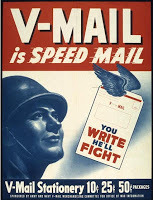 70 Years Ago—June 15, 1942: USS Copaheecommissioned as first escort carrier, converted from merchant ship. US nationwide rubber scrap drive begins; will bring in 450,000 tons. US institutes V-Mail system to microfilm overseas mail and maximize shipping space.
70 Years Ago—June 15, 1942: USS Copaheecommissioned as first escort carrier, converted from merchant ship. US nationwide rubber scrap drive begins; will bring in 450,000 tons. US institutes V-Mail system to microfilm overseas mail and maximize shipping space.
Published on June 15, 2012 03:00
June 14, 2012
Ten Steps to Salvation!!!...Or Not...
 Ten steps to perfects abs! Five steps to a happy marriage! Twenty ways to earn more money!
Ten steps to perfects abs! Five steps to a happy marriage! Twenty ways to earn more money!Most people say they want things easy, but on the contrary, our human instinct longs for steps and rules. One look at a magazine cover proves it. It’s about control. If we have steps to follow, we can control the outcome. We can have a toned body, a peaceful home, and gobs of money.A simple look at all the world’s religions from the beginning of time starkly shows this instinct in action. Man-made religions have lots of steps and rules. By their own actions, the adherents hope to earn eternal life, if only they work hard enough and do everything right.
Jesus offered something different and radical. He gave one command—“Follow me.” The simplicity of the Christian message proves it comes from God, not man. But the simplicity of the Christian message makes it hard for people to fathom. Jesus asks us to give up control, accept the fact that we can never earn eternal life by our own power, and follow the only source of Life.That’s why the rich young ruler in Mark 10 turned away. He asked Jesus, “‘What must I do to inherit eternal life’” (Mark 10:17, italics mine). He’d followed the Ten Commandments but knew in his soul it wasn’t enough. He wanted an Eleventh Commandment, one more good thing to do to tip him over the edge. Instead, Jesus asked him to surrender, to give up the one thing he loved more than the Lord (his money), and to follow Him. And the man turned away.
Jesus then said, "'It is easier for a camel to go through the eye of a needle than for a rich man to enter the kingdom of God'" (Mark 10:25). Why? Could it be because the rich man has obtained everything he's ever wanted by his own power? Because an achievement-oriented person finds it extraordinarily difficult to give up control? Because he or she will always be searching for more steps, more good things to do? Because simplicity is more difficult to accept than complexity?
Here is the paradox Jesus offered...
In ceasing to strive, we gain what we could never earn. In one step, we receive as a gift from God what we could never achieve in a thousand steps. In surrender is victory.“It is by grace you have been saved, through faith—and this not from yourselves, it is the gift of God—not by works, so that no one can boast” Ephesians 2:8-9.
Published on June 14, 2012 05:00
Today in World War II History
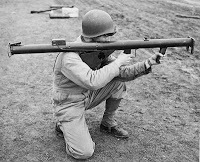 70 Years Ago—June 14, 1942: British Air Marshal Arthur Harris knighted. First firing of bazooka, at Bridgeport, Connecticut.
70 Years Ago—June 14, 1942: British Air Marshal Arthur Harris knighted. First firing of bazooka, at Bridgeport, Connecticut.
Published on June 14, 2012 03:00
June 13, 2012
Today in World War II History
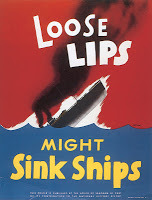 70 Years Ago—June 13, 1942: Rommel defeats British at Knightsbridge in Libya; heavy British casualties on “Black Saturday.” US forms Office of Strategic Services (OSS), precursor of CIA. US forms Office of War Information to oversee radio, movies, press, and to disseminate propaganda. Four German saboteurs landed by U-boat at Amagansett, Long Island.
70 Years Ago—June 13, 1942: Rommel defeats British at Knightsbridge in Libya; heavy British casualties on “Black Saturday.” US forms Office of Strategic Services (OSS), precursor of CIA. US forms Office of War Information to oversee radio, movies, press, and to disseminate propaganda. Four German saboteurs landed by U-boat at Amagansett, Long Island.
Published on June 13, 2012 03:00
June 12, 2012
Today in World War II History
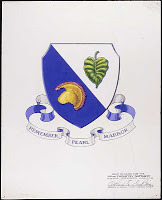 70 Years Ago—June 12, 1942: Anne Frank receives a diary for her thirteenth birthday. US B-24s flying from Egypt attack Ploesti in first US strategic mission of war. US 100th Infantry Battalion activated, composed of Japanese-Americans from Hawaii.
70 Years Ago—June 12, 1942: Anne Frank receives a diary for her thirteenth birthday. US B-24s flying from Egypt attack Ploesti in first US strategic mission of war. US 100th Infantry Battalion activated, composed of Japanese-Americans from Hawaii.
Published on June 12, 2012 03:00



